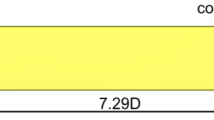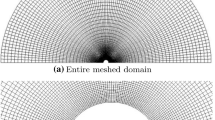Abstract
The transient shock dynamics and drag characteristics of a projectile flying through a pipe 3.55 times larger than its diameter at transonic speed are analyzed by means of time-of-flight and pipe wall pressure measurements as well as computational fluid dynamics (CFD). In addition, free-flight drag of the 4.5-mm-pellet-type projectile was also measured in a Mach number range between 0.5 and 1.5, providing a means for comparison against in-pipe data and CFD. The flow is categorized into five typical regimes the in-pipe projectile experiences. When projectile speed and hence compressibility effects are low, the presence of the pipe has little influence on the drag. Between Mach 0.5 and 0.8, there is a strong drag increase due to the presence of the pipe, however, up to a value of about two times the free-flight drag. This is exactly where the nose-to-base pressure ratio of the projectile becomes critical for locally sonic speed, allowing the drag to be estimated by equations describing choked flow through a converging–diverging nozzle. For even higher projectile Mach numbers, the drag coefficient decreases again, to a value slightly below the free-flight drag at Mach 1.5. This behavior is explained by a velocity-independent base pressure coefficient in the pipe, as opposed to base pressure decreasing with velocity in free flight. The drag calculated by CFD simulations agreed largely with the measurements within their experimental uncertainty, with some discrepancies remaining for free-flying projectiles at supersonic speed. Wall pressure measurements as well as measured speeds of both leading and trailing shocks caused by the projectile in the pipe also agreed well with CFD.

















Similar content being viewed by others
Abbreviations
- \(\rho \) :
-
Density
- \(\gamma \) :
-
Ratio of specific heat capacities
- \(A_{{\mathrm {d}}}\) :
-
Area of pipe cross section
- \(A_{{\mathrm {p}}}\) :
-
Projectile projected area
- \(A^{*}\) :
-
Area in smallest cross section \(\left( A_{{\mathrm {d}}}-A_{{\mathrm {p}}}\right) \)
- \(a_{{\mathrm {p}}}\) :
-
Projectile acceleration
- \(C_{{\mathrm {d}}}\) :
-
Drag coefficient
- \(C_{{\mathrm {d,n}}}\) :
-
Nose drag coefficient
- \(C_{{\mathrm {d,b}}}\) :
-
Base drag coefficient
- D :
-
Diameter of the projectile
- M :
-
Mach number
- \(M_{{\mathrm {p}}}\) :
-
Projectile Mach number
- \(m_{{\mathrm {p}}}\) :
-
Projectile mass
- \({\dot{m}}\) :
-
Mass flux rate
- \(\dot{m}_{{\mathrm {n}}}\) :
-
Mass flux rate through smallest cross section
- p :
-
Static pressure
- \(p_{{\mathrm {t}}}\) :
-
Total pressure
- R :
-
Specific gas constant
- t :
-
Time
- T :
-
Static temperature
- \(T_{{\mathrm {t}}}\) :
-
Total temperature
- v :
-
Velocity
- \(v_{{\mathrm {p}}}\) :
-
Projectile velocity
- \(v_{{\mathrm {s,l}}}\) :
-
Leading shock velocity
- \(v_{{\mathrm {s,t}}}\) :
-
Trailing shock velocity
- x :
-
Projectile position
References
Sahu, J.: Drag predictions for projectiles at transonic and supersonic speeds. Technical Report BRL-MR-3523, Ballistic Research Laboratory (1986)
Nietubicz, C.J., Sturek, W.: Navier–Stokes code verification for projectile configurations at supersonic and transonic velocities. In: 15th Aerodynamic Testing Conference, Aerodynamic Testing Conference. AIAA Paper 1988-1995 (1988). https://doi.org/10.2514/6.1988-1995
Doig, G.: Transonic and supersonic ground effect aerodynamics. Prog. Aerosp. Sci. 69, 1–28 (2014). https://doi.org/10.1016/j.paerosci.2014.02.002
Doig, G., Barber, T.J., Leonardi, E., Neely, A.J., Kleine, H.: Aerodynamics of a supersonic projectile in proximity to a solid surface. AIAA J. 48(12), 2916–2930 (2010). https://doi.org/10.2514/1.J050505
Czysz, P.A.: Correlation of wind tunnel blockage data. Technical Report ASD-TDR-63-230, NACA (1963)
Kantrowitz, A., Donaldson, C.: Preliminary investigation of supersonic diffusers. Technical Report NACA WR-L-713, NACA (1945)
Hill, P.G., Peterson, C.R.: Mechanics and Thermodynamics of Propulsion, 2nd edn. Addison-Wesley, Reading (1992)
Braun, J., Sousa, J., Pekardan, C.: Aerodynamic design and analysis of the hyperloop. AIAA J. 55(12), 4053–4060 (2017). https://doi.org/10.2514/1.J055634
Herrin, J.L., Dutton, J.C.: Supersonic base flow experiments in the near wake of a cylindrical afterbody. AIAA J. 32(1), 77–83 (1994). https://doi.org/10.2514/3.11953
Hertzberg, A., Bruckner, A.P., Bogdanoff, D.W.: Ram accelerator: A new chemical method for accelerating projectiles to ultrahigh velocities. AIAA J. 26(2), 195–203 (1988). https://doi.org/10.2514/3.9872
Anderson, J.D.: Modern Compressible Flow, 3rd edn. McGraw-Hill, New York (2010)
McCoy, R.: Modern Exteriour Ballistics. Schiffer Military History, Atglen (2010)
Venkataraman, P., Nilsen, C., Corey, K.: Airgun pellet performance using computational fluid mechanics. In: 12th Applied Aerodynamics Conference, Fluid Dynamics and Co-located Conferences. AIAA Paper 1994-1940 (1994). https://doi.org/10.2514/6.1994-1940
Holden, M.S., Chadwick, K.M., Gallis, M.A., Harvey, J.K.: Comparison between shock-tunnel measurements on a planetary-probe configuration and DSMC predictions. In: Proceedings of the 20th International Symposium on Shock Waves, pp. 179–184 (1996)
Ansys Fluent User’s Guide, Release 13.0. ANSYS, Inc. (2010)
Roache, P.J., Ghia, K., White, F.: Editorial policy statement on the control of numerical accuracy. ASME J. Fluids Eng. 108(1), 2–6 (1986). https://doi.org/10.1115/1.3242537
DeSpirito, J., Heavey, K.: CFD computation of Magnus moment and roll damping moment of a spinning projectile. In: AIAA Atmospheric Flight Mechanics Conference and Exhibit, Guidance, Navigation, and Control and Co-located Conferences. AIAA Paper 2004-4713 (2004). https://doi.org/10.2514/6.2004-4713
Doraiswamy, S., Candler, G.V.: Detached eddy simulations and Reynolds-averaged Navier–Stokes calcuations of a spinning projectile. J. Spacecr. Rockets 45(5), 935–945 (2008). https://doi.org/10.2514/1.31935
Forsythe, J.R., Hoffmann, K.A., Cummings, R.M., Squires, K.D.: Detached eddy simulation with compressibility corrections applied to a supersonic axisymmetric base flow. J. Fluids Eng. 124(4), 911–923 (2002). https://doi.org/10.1115/1.1517572
Baurle, R.A., Tam, C.J., Edwards, J.R., Hassan, H.A.: Hybrid simulation approach for cavity flows: blending, algorithm, and boundary treatment issues. AIAA J. 41(8), 1463–1480 (2003). https://doi.org/10.2514/2.2129
Simon, F., Deck, S., Guillen, P., Sagaut, P.: Reynolds-averaged Navier–Stokes/large-eddy simulations of supersonic base flow. AIAA J. 44(11), 2578–2590 (2006). https://doi.org/10.2514/1.21366
Kawai, S., Fujii, K.: Computational study of supersonic base flow using hybrid turbulence methodology. AIAA J. 43(6), 1265–1275 (2005). https://doi.org/10.2514/1.13690
Author information
Authors and Affiliations
Corresponding author
Additional information
Communicated by O. Igra and A. Higgins.
Rights and permissions
About this article
Cite this article
Hruschka, R., Klatt, D. In-pipe aerodynamic characteristics of a projectile in comparison with free flight for transonic Mach numbers. Shock Waves 29, 297–306 (2019). https://doi.org/10.1007/s00193-018-0816-2
Received:
Revised:
Accepted:
Published:
Issue Date:
DOI: https://doi.org/10.1007/s00193-018-0816-2




